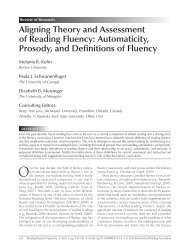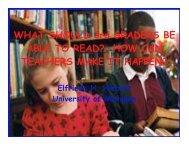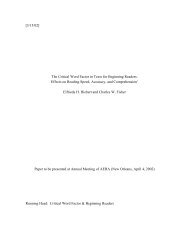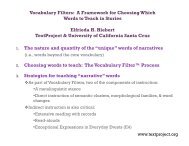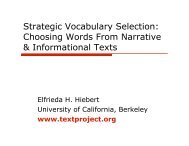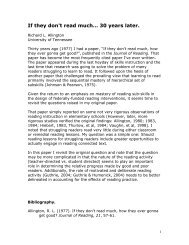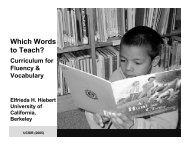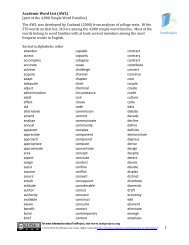<strong>TextProject</strong> R E A D I N G R E S E A R C H R E P O R T #11.02of teachers’ lessons or workbook exercises, but not in the narratives that comprisethe core reading programs commonly used in ELA instruction. It is highlyunlikely, for example, to find a narrative that uses any of the words that arelisted as the ELA vocabulary for grades 3–5 such as contraction or inference.A comparison of vocabulary in ELA and content-area textsA comparison of the words identified for instruction within the ELA and sciencetextbooks, fourth-grade programs, of the same publishers also illustratesthe qualities of literary vocabulary (Hiebert & Cervetti, 2011). For the ELAprogram, publishers had identified 209 words, seven from each selection, forthe focus of instruction and assessment. The 207 focus words in the scienceprogram were distributed across 19 lessons, each with an average of 11 words.Hiebert and Cervetti established six features of the 416 words: a) length ofwords; (b) predicted frequency per one million words of text (Zeno et al.,1995); (c) morphological frequency: the predicted frequency per one millionwords of text of the words transparently related to the focus word (Zeno et al.,1995); (d) familiarity (Biemiller, 2008; Dale & O’Rourke, 1976); (e) dispersion,which indicates how widely a word appears in different subject areas (Zeno etal., 1995); and (f) conceptual complexity (Hiebert & Cervetti, 2011).The features of words in narrative and informational texts were statisticallydifferent on all measures except for the frequency of morphological familiesof words and the dispersion index. On three of the remaining four features—length, familiarity, and conceptual complexity—the focus ELA words had averagesthat classed them as “easier” than the focus science words. On the fourthfeature, frequency, the ELA words were deemed harder than the science words,with an average frequency of 14 occurrences per one million words of texts forthe former and 39 for the latter. The target ELA words, then, were somewhatshorter, more familiar, and less conceptually complex than the target sciencevocabulary, but they were less frequent.4An analysis of all unique words in an ELA programA view of the vocabulary demands of narrative texts comes from an analysisthat identified the entire pool of words from which the focus words at thebeginning of this essay came. The analysis began with all 6,410 words in thefive texts of the focus unit (Afflerbach et al., 2007). Of these words, 1,204 wereunique or distinctive words.The frequency of these words was established through the WordZones Profiler(WZP; Hiebert, 2011) that draws on the Zeno et al. (1995) database. The eightword zones within the WZP differ according to the frequency with whichwords in a zone are predicted to occur in one million words of text. A smallgroup of words (930) make up zones 0–2. These words occur at least 100 ormore times per one million words of text. Approximately 4,900 words are inzones 3 and 4 where words are predicted to appear with moderate frequency(from 10 to 99 times per one million words). The approximately 8,240 words
<strong>Vocabulary</strong> <strong>Megaclusters</strong>TABLE 2WordZone Distribution of Entire, Unique, and Target <strong>Vocabulary</strong>: ELAProgramWordZonesTotal Words(n=6420)Unique Words33 Target <strong>Vocabulary</strong> Words(n=1240)proportion repetitions (X) proportion repetitions (X)0–2 .81 .50 8.3 0 NA3 .06 .15 2.1 .09 2.34 .09 .15 1.9 .27 1.45 .02 .13 2.0 .42 2.16 .01 .03 1.3 .15 17 .02 .04 2.6 .06 1that make up zone five are relatively rare (2 to 9 appearances per one millionwords). A group of approximately 5,650 words occur about once per one millionwords and make up zone six. The remaining words fall in zone seven andoccur less than once per one million (approximately 135,475 words in the Zenoet al. analysis of a 17.25-million-word corpus).The distribution of the unique words in the five texts into the word zones appearsin Table 2. It is the words of zones 5 and 6 that vocabulary instructionwill likely emphasize since students are unlikely to have encountered thesewords previously in text. Words in zones 0–4 are ones which fourth-gradersshould know since these are words that are used frequently in their texts. Ofthe words chosen for instruction, approximately 63% were rare words. Most ofthese words appear once in the entire unit. Another 24% appeared 2–3 times.The remaining 10% appeared 4 times or more. Only 2% of this group appearedthe requisite 10 times or more. The 33 words that introduced this essay representapproximately 5% of the rare/moderate words in the texts.What can be concluded from this analysis is that there are numerous single-appearingwords in narrative texts that appear infrequently in written language asa whole. It would be impossible for teachers to cover all of the words in lessons,even for a single text. Further, since the words can be exceedingly diverse inmeaning, the instructional approach and task would be arduous. Finally, sincealmost all of these rare words appear infrequently in the text and are unlikelyto reappear again in the texts that students are reading in other content areas,the longevity of students’ learning—even of words that are taught intensivelybut appear a single time in a text—is uncertain.A Description of the <strong>Vocabulary</strong> Megacluster ApproachNarratives have particular features, most notably a setting, problem, goal, action,outcome, resolution, and theme (Stein & Glenn, 1979; Whaley, 1981). Thestructure of narratives, as Bruner argued (1990), mirrors the way in which hu-5





